INNOVATION METHOD ONLINE PEER ASSISTED LEARNING TO LEARNING SATISFACTION THORAX PHYSICAL EXAMINATION SKILLS
DOI:
https://doi.org/10.34035/jk.v12i1.621Keywords:
Kepuasan, Online, Peer Asisted Learning, Learning SatisfactionAbstract
Kepuasan belajar mahasiswa menjadi salah satu tolok ukur keberhasilan sistem pendidikan yang diterapkan di sebuah institusi. Kepuasan belajar juga merupakan salah satu faktor yang dapat memprediksi hasil belajar. Sebagai upaya meningkatkan kepuasan belajar mahasiswa pada pembelajaran keterampilan klinik, perlu bagi institusi pendidikan untuk memberikan inovasi pembelajaran berbasis teknologi. Metode yang ditawarkan adalah Online peer-assisted learning. Tujuan dalam penelitian ini adalah untuk mengetahui perbedaan kepuasan belajar pemeriksaan fisik thorak sebelum dan setelah diterapkan metode Online peer assisted learning. Penelitian ini menggunakan desain Quasy Experimental, dengan pendekatan post-test control group design. Populasi penelitian ini adalah mahasiswa keperawatan tahun kedua STIKes Surya Global sebanyak 140 mahasiswa. Jumlah responden 70 diambil dengan tekhnik simple random sampling menjadi kelompok kontrol dan intervensi. Kelompok intervensi diberikan model pembelajaran Peer-assisted learning (PAL) dengan bantuan teknologi video call dalam whatsapp. Kelompok kontrol dengan model pembelajaran Peer-assisted learning face to face seperti yang selama ini dilakukan. Instrumen kepuasan belajar dalam penelitian ini diadopsi dari penelitian Cohen dan Baruth. Analisis data menggunakan uji independet t test untuk membandingkan rata-rata nilai posttest kepuasan belajar. Hasil analisis menunjukan terdapat peningkatan kepuasan belajar secara signifikan dengan nilai p value 0.001. Rerata nilai kepuasan belajar metode Online Peer Asisted Learning (OPAL 41,65 (SD = 2,85), dan nilai rerata kepuasan belajar dengan metode Peer Asisted Learning (PAL) 39,05 (SD =3,10). Metode Online peer assisted learning (OPAL) terbukti mempunyai pengaruh yang signifikan terhadap kepuasan belajar keterampilan pemeriksaan fisik thorak pada mahasiswa keperawatan.
Student learning satisfaction is one of the benchmarks for the success of the education system implemented in an institution. Learning satisfaction is also one of the factors that can predict learning outcomes. In an effort to increase student learning satisfaction in clinical skills learning, it is necessary for educational institutions to provide technology-based learning innovations. The method offered is online peer-assisted learning. The purpose of this study was to determine differences in learning satisfaction in the physical examination of Thorax before and after the online peer assisted learning method was applied. This study used a Quasy Experimental design, with a post-test control group design approach. The population of this study were 140 students of the second year of STIKes Surya Global nursing students. Respondents 70 were taken by simple random sampling technique into the control and intervention groups. The intervention group was given a Peer-assisted learning (PAL) learning model with the help of video call technology in WhatsApp. The control group uses the face-to-face peer-assisted learning model as has been done so far. The learning satisfaction instrument in this study was adopted from Cohen and Baruth's research. The data analysis used the independent t test to compare the average posttest scores for learning satisfaction. The analysis showed that there was a significant increase in learning satisfaction with a p value of 0.001. The mean value of learning satisfaction with the Online Peer Asisted Learning method (OPAL 41.65 (SD = 2.85), and the average value of learning satisfaction with the Peer Asisted Learning (PAL) method is 39.05 (SD = 3.10). Online peer assisted method Learning (OPAL) is proven to have a significant effect on the learning satisfaction of Thoracic physical examination skills in nursing students.
References
Downloads
Published
Issue
Section
License
Copyright (c) 2021 Jurnal Kesehatan Kusuma Husada

This work is licensed under a Creative Commons Attribution 4.0 International License.
The copyright of the published articles belongs to Jurnal Kesehatan Kusuma Husada.

This work is licensed under a Creative Commons Attribution 4.0 International License.
















